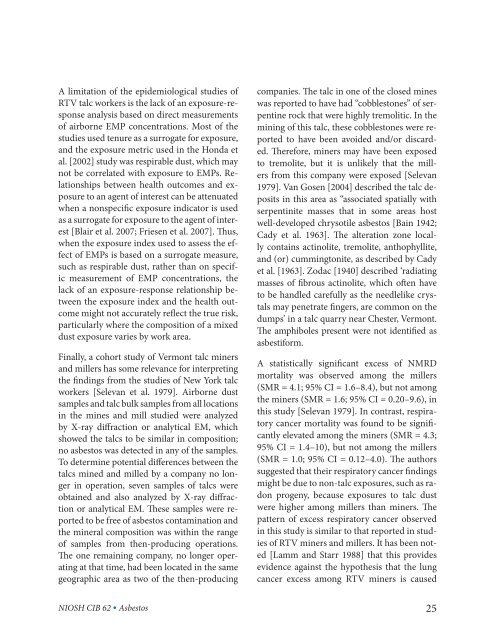Asbestos Fibers and Other Elongate Mineral Particles: State of the ...
Asbestos Fibers and Other Elongate Mineral Particles: State of the ...
Asbestos Fibers and Other Elongate Mineral Particles: State of the ...
- No tags were found...
Create successful ePaper yourself
Turn your PDF publications into a flip-book with our unique Google optimized e-Paper software.
A limitation <strong>of</strong> <strong>the</strong> epidemiological studies <strong>of</strong><br />
RTV talc workers is <strong>the</strong> lack <strong>of</strong> an exposure-response<br />
analysis based on direct measurements<br />
<strong>of</strong> airborne EMP concentrations. Most <strong>of</strong> <strong>the</strong><br />
studies used tenure as a surrogate for exposure,<br />
<strong>and</strong> <strong>the</strong> exposure metric used in <strong>the</strong> Honda et<br />
al. [2002] study was respirable dust, which may<br />
not be correlated with exposure to EMPs. Relationships<br />
between health outcomes <strong>and</strong> exposure<br />
to an agent <strong>of</strong> interest can be attenuated<br />
when a nonspecific exposure indicator is used<br />
as a surrogate for exposure to <strong>the</strong> agent <strong>of</strong> interest<br />
[Blair et al. 2007; Friesen et al. 2007]. Thus,<br />
when <strong>the</strong> exposure index used to assess <strong>the</strong> effect<br />
<strong>of</strong> EMPs is based on a surrogate measure,<br />
such as respirable dust, ra<strong>the</strong>r than on specific<br />
measurement <strong>of</strong> EMP concentrations, <strong>the</strong><br />
lack <strong>of</strong> an exposure-response relationship between<br />
<strong>the</strong> exposure index <strong>and</strong> <strong>the</strong> health outcome<br />
might not accurately reflect <strong>the</strong> true risk,<br />
particularly where <strong>the</strong> composition <strong>of</strong> a mixed<br />
dust exposure varies by work area.<br />
Finally, a cohort study <strong>of</strong> Vermont talc miners<br />
<strong>and</strong> millers has some relevance for interpreting<br />
<strong>the</strong> findings from <strong>the</strong> studies <strong>of</strong> New York talc<br />
workers [Selevan et al. 1979]. Airborne dust<br />
samples <strong>and</strong> talc bulk samples from all locations<br />
in <strong>the</strong> mines <strong>and</strong> mill studied were analyzed<br />
by X-ray diffraction or analytical EM, which<br />
showed <strong>the</strong> talcs to be similar in composition;<br />
no asbestos was detected in any <strong>of</strong> <strong>the</strong> samples.<br />
To determine potential differences between <strong>the</strong><br />
talcs mined <strong>and</strong> milled by a company no longer<br />
in operation, seven samples <strong>of</strong> talcs were<br />
obtained <strong>and</strong> also analyzed by X-ray diffraction<br />
or analytical EM. These samples were reported<br />
to be free <strong>of</strong> asbestos contamination <strong>and</strong><br />
<strong>the</strong> mineral composition was within <strong>the</strong> range<br />
<strong>of</strong> samples from <strong>the</strong>n-producing operations.<br />
The one remaining company, no longer operating<br />
at that time, had been located in <strong>the</strong> same<br />
geographic area as two <strong>of</strong> <strong>the</strong> <strong>the</strong>n-producing<br />
NIOSH CIB 62 • <strong>Asbestos</strong><br />
companies. The talc in one <strong>of</strong> <strong>the</strong> closed mines<br />
was reported to have had “cobblestones” <strong>of</strong> serpentine<br />
rock that were highly tremolitic. In <strong>the</strong><br />
mining <strong>of</strong> this talc, <strong>the</strong>se cobblestones were reported<br />
to have been avoided <strong>and</strong>/or discarded.<br />
Therefore, miners may have been exposed<br />
to tremolite, but it is unlikely that <strong>the</strong> millers<br />
from this company were exposed [Selevan<br />
1979]. Van Gosen [2004] described <strong>the</strong> talc deposits<br />
in this area as “associated spatially with<br />
serpentinite masses that in some areas host<br />
well-developed chrysotile asbestos [Bain 1942;<br />
Cady et al. 1963]. The alteration zone locally<br />
contains actinolite, tremolite, anthophyllite,<br />
<strong>and</strong> (or) cummingtonite, as described by Cady<br />
et al. [1963]. Zodac [1940] described ‘radiating<br />
masses <strong>of</strong> fibrous actinolite, which <strong>of</strong>ten have<br />
to be h<strong>and</strong>led carefully as <strong>the</strong> needlelike crystals<br />
may penetrate fingers, are common on <strong>the</strong><br />
dumps’ in a talc quarry near Chester, Vermont.<br />
The amphiboles present were not identified as<br />
asbestiform.<br />
A statistically significant excess <strong>of</strong> NMRD<br />
mortality was observed among <strong>the</strong> millers<br />
(SMR = 4.1; 95% CI = 1.6–8.4), but not among<br />
<strong>the</strong> miners (SMR = 1.6; 95% CI = 0.20–9.6), in<br />
this study [Selevan 1979]. In contrast, respiratory<br />
cancer mortality was found to be significantly<br />
elevated among <strong>the</strong> miners (SMR = 4.3;<br />
95% CI = 1.4–10), but not among <strong>the</strong> millers<br />
(SMR = 1.0; 95% CI = 0.12–4.0). The authors<br />
suggested that <strong>the</strong>ir respiratory cancer findings<br />
might be due to non-talc exposures, such as radon<br />
progeny, because exposures to talc dust<br />
were higher among millers than miners. The<br />
pattern <strong>of</strong> excess respiratory cancer observed<br />
in this study is similar to that reported in studies<br />
<strong>of</strong> RTV miners <strong>and</strong> millers. It has been noted<br />
[Lamm <strong>and</strong> Starr 1988] that this provides<br />
evidence against <strong>the</strong> hypo<strong>the</strong>sis that <strong>the</strong> lung<br />
cancer excess among RTV miners is caused<br />
25

















